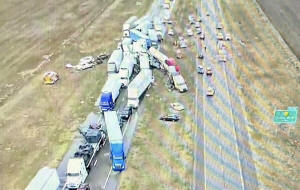A highway pileup in western Kansas shows how dust storms can turn deadly
[March 18, 2025]
By JOHN HANNA
TOPEKA, Kan. (AP) — A gust of wind sweeps over bare soil, kicking up
enough dirt and dust to cut visibility to nearly zero, and for drivers,
the dust storm seems to come out of nowhere.
Such conditions resulted in a pileup on Interstate 70 last week in
western Kansas involving dozens of cars and trucks that left eight
people dead. Blinding dust also prompted New Mexico's transportation
department to close Interstate 25 from the Colorado border southwest to
Las Vegas, New Mexico.
Hazy or dust-darkened skies have recalled the “Dust Bowl” of the 1930s,
when millions of tons of blowing soil buried farms and coated towns
across the Great Plains. Lesser storms occur every year, particularly in
the western U.S., particularly when farmland hasn't been planted yet in
the spring. Some scientists worry that many motorists don't take them
seriously enough.
“We have a very low level of public awareness of a dust storm and what
damage it can cause,” said Daniel Tong, an associate professor of
atmospheric chemistry at George Mason University who is among the
authors of a 2023 paper on dust storm deaths.
Dust storms have a history of causing fatalities
The High Plains Museum in Goodland displays a photo of a tractor buried
in blown soil in the 1930s, a reminder of the consequences of a severe
drought across the Great Plains that came after farming had destroyed
native grasses.
The fatalities Friday near Goodland were the first in the area in a dust
storm since 2014, said Jeremy Martin, the Weather Service meteorologist
in charge there.

But they came less than a month after an 11-car pileup on I-25 left
three people dead, with heavy dust cited as a factor, according to
Albuquerque TV's KRQE. Similarly, a dust storm on I-55 between St. Louis
and Springfield, Illinois, in 2023 led to a fatal pileup involving
dozens of vehicles.
In 1991, 17 people died in an accident involving more than 100 vehicles
on I-5 in California's San Joaquin Valley, blamed on blowing dust.
Tong and four co-authors concluded in their paper published in 2023 in
the Bulletin of the American Meteorological Society that there were 232
deaths from “windblown dust events” from 2007 through 2017, far higher
than the number recorded by National Oceanic and Atmospheric Association
data.
In January, he and four colleagues concluded that the economic damaged
caused by wind erosion and dust is four times higher than previously
calculated and more than $154 billion a year.
A cold front carries dust through western Kansas
Martin said a cold front moved through the area of the pileup after it
had been warm and dry for six hours. Winds that reached 70 miles per
hour (113 kph) kicked up dust that then became trapped in the cold
front.
“That's when you get that classic wall of dust," he said.
[to top of second column]
|

This image provided by the Kansas Highway Patrol shows the aftermath
of a pileup on Interstate 70 near Goodland, Kan., caused by a dust
storm and involving more than 70 vehicles, Friday, March 14, 2025.
(Kansas Highway Patrol via AP)

As blowing dust cut visibility on the road to almost zero, drivers
slowed down, causing collisions, authorities said.
A preliminary investigation found that 71 vehicles were involved,
said Kansas Highway Patrol spokesperson April McCollum. Aerial
photos showed at least 10 were semis.
“It was hard to even keep your eyes open outside because there was
so much dust in the air,” said Jeremy Martin, the National Weather
Service meteorologist in charge in Goodland. “It kind of stung to
even breathe out in it.”
Similar conditions in eastern Colorado prompted the Colorado State
Patrol to warn drivers: “Zero visibility due to high winds and
blowing dirt.”
“You couldn’t see,” said Jerry Burkhart, the fire and emergency
services chief in Lamar, Colorado. “The best thing to do is get way
off the road in a parking lot or something like that.”
A lack of visibility is not the only problem
Martin said it's hard to tell how thick dust is from a distance, so
motorists often don't know they won't able to see until they're in
it.
Weather Service forecasters also said some of the advice for
motorists in a dust storm is counter-intuitive. Michael Anand, a NWS
meteorologist in Albuquerque, said motorists should pull off the
road as safely as possible, turn off all lights and never use their
high beams.
“You don’t want people behind you to think you’re going in the
road,” Martin said. “That light from your tail light might be the
only thing they can see. They’re thinking the road suddenly curves.”
High winds make cars harder to control, and a dust storm coats the
road with fine particles that slow breaking, and drivers panic, Tong
said.
He said dust storms are frequent and widespread enough across the
U.S. that states should test prospective drivers on what to do in a
dust storm on license exams.
“That could be, actually, a very easy way to educate drivers,” he
said.
___
Associated Press writer Janie Far in San Francisco contributed.
All contents © copyright 2025 Associated Press. All rights reserved
 |